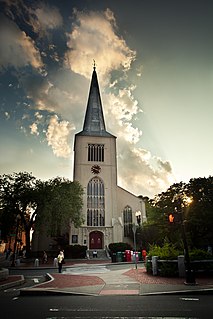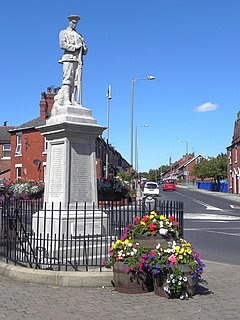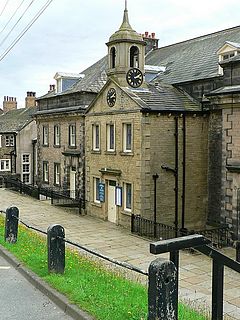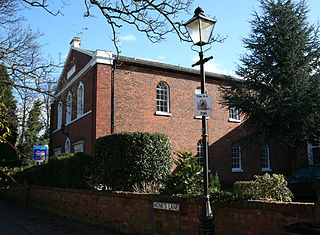
The following is a list of Inghamite chapels, churches and meeting houses built by followers of Benjamin Ingham, an evangelist from Ossett, Yorkshire.
In the middle of the 18th century, Ingham founded a number of Non-conformist Christian societies, chiefly in the Pennine areas of Lancashire and Yorkshire. These 'societies' formed the basis of local congregations which met in chapels as their place of worship. Less commonly some are referred to as churches, or meeting houses. Many of these chapels were funded and built new for this purpose by benefactors in the Inghamite societies. At the height of their popularity around 100 Inghamite Chapels are believed to have existed,[ citation needed ] including one in Ontario, Canada.
Following the death of their founder, congregations gradually declined: the number of active chapels had reduced to 16 chapels in 1814,[ citation needed ] seven chapels in 1918, and only two (Wheatley Lane and Salterforth) survived into the 21st century. In 2019, only Wheatley Lane remained open. [1] [2] The church in Ontario survives, but no longer calls itself Inghamite. [3]
The following list is based chiefly on that given in a 1958 book by Robert Walker Thomson, [4] which in turn quotes from an older source. [5] Supporting information is also drawn from P.J.Oates' book. [6] Chapels and meeting houses which had closed before 1813 are not included.
| Location (with OS GRID REF) | Opened / Closed | Notes |
|---|---|---|
| Lancashire | ||
| Colne Field, Colne SD 897 403 | 1760s / 1840s | Located off Keighley Road to the east of the cemetery. Later becoming a school, now two cottages. |
| Colne Lane, Colne SD 890 400 | 1826 / 1908 | Was originally a Baptist chapel (1788/1826). After life as an Inghamite chapel it was sold to the Pentecostal Church (1908) |
| Ludgate Circus, Colne | 1908 / 1951 | Replaced the chapel at Colne Lane |
| West Street, Colne | 1951 / 1976 | Replaced the chapel at Ludgate Circus |
| Cotton Tree Lane, Colne SD 905 401 | 1900 / 1993 | Formed by a breakaway congregation from Winewall Inghamite Chapel following a disagreement. Building was closed in 1993 and demolished in 1996 to be replaced with new houses. |
| Haslingden | 1803 / before 1851 | (Room only in Pleasant Street) |
| Russell Street, Nelson | 1886 / 1957 | Building sold to Salvation Army in 1957 becoming the Salvation Army Citadel |
| Rodhill, nr Grindleton SD 761 479 | 1754 / 1837 | (formerly in West Riding of Yorkshire). Subsequently used by the Methodists 1844 - 1863. |
 Wheatley Lane, Fence, Burnley SD 838 384 | 1750 / open | The largest chapel remaining by 1814. Now the only chapel still open. It is a member of the Fellowship of Independent Evangelical Churches |
| Winewall, near Colne SD 911 398 | 1752 / 2001 | A second chapel was built in 1860, original then becoming a day school. After storm damage the later chapel was demolished in 1979, and the first chapel was part converted back to its original usage. Last service held September 1998. Permanently closed 2001. [7] Now residential flats. Large graveyard still exists at rear. |
| Nottinghamshire | ||
| Bulwell, nr Nottingham | 1803 / 1817 | Established by members from St Mary's Gate chapel. Unlikely a building ever existed |
| St Mary's Gate Chapel, Nottingham | 1800 / 1844 | Built at the lower end of St Mary's Gate on the west side. No trace of church exists today |
| Westmorland | ||
| Birks, Warcop, Eden Valley NY 719 151 | 1757 / 1837 | Located on a hill top 2 miles west of Warcop. Only an Inghamite chapel up to 1813, then becoming Congregational.Now a barn |
 Bankfield Road, Kendal SD 511 924 | 1844 / 1971 | Known as "Pear Tree" Inghamite Chapel, named after Pear Tree Barn where meetings were held from 1757 until the new chapel was built in 1844. Chapel converted into housing in 1985 |
| Yorkshire (West Riding) | ||
| Cowgill, Dentdale | 1754 / 1830s | Probably ceased holding meetings late 1770s |
| New House chapel, Gisburn SD 832 539 | 1839 / 1850s | |
| Duke Street, Leeds | 1788 / 1853 | |
| Ossett | Chapel building was possibly in Back Lane | |
 Earby Road, Salterforth SD 890 455 | 1754 / c.2010 | New / rebuilt chapel opened in 1932 |
| Stansfield, Halifax | 1787 / 1867 | Location uncertain either Blind Lane or Ferney Lee Road, just off Burnley Road |
| Chapel Street, Tadcaster | 1814 / ? | Chapel possibly rebuilt 1840 |
| Thinoaks, Clapham SD 707 685 | 1757 / 1820s | Now used as a barn at Oaklands Farm off the Clapham to Bentham road |
| Blind Lane, Todmorden | 1787 / ? | . Actually at bottom of Ferney Lee Rd. Now private house named Fern House. |
| Tosside | ||
| Wibsey, nr Bradford | 1758 / c1820s | |
| Yorkshire (East Riding) | ||
| Howden, nr Goole | 1788 / 1850 | Sold to the Wesleyan church in 1850. Demolished late 20th century |
| Canada | ||
| Farringdon, Brantford, Ontario | 1839 / open | Founded by members from Pear Tree Chapel, Kendal [8] |















